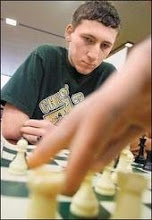Madison - Anzis
2009 Iowa Closed Championship, Round 3
1. d4 d5 2. c4 c6 3. Nf3 Nf6 4. Nc3 e6 5. e3 Bd6 6. Qc2 Nbd7 7. g4!?
We have now reached my favorite variation in all of chess. Utter chaos usually develops.
7. ...b6?
The usual moves for black include 7. ...h6 and 7. ...Nxg4 8. Rg1 Qf6! 9. Rxg4 Qxf3 10. Rxg7=
8. g5! +/-
White already gets a large advantage due to the early g5.
8. ...Ng8 9. Bd2 Ne7 10. e4!?

About time for a diagram. We are more or less into the middlegame, and it is clear that this will be an uphill battle for black. White has a large space advantage on the kingside, more active pieces, and a small lead in development. What black has going for him right now is a lack of targets for white to attack. The unfortunate thing for black, however, is that in order to develop their pieces, he will have to create weaknesses.
10. ...Bb7 11. cxd5 cxd5 12. e5! Bb8 13. Bd3 a6 14. b4
Black is getting pushed around at white's whim. b4 threatens to play 15. b5!, which will permanently lock out the black bishops.
14. ...b5! 15. a4 bxa4 16. Nxa4 Ba7 17. Nc5 Bxc5 18. bxc5

We have a rare instance here of white being in control of all three parts of the board. Despite the closed center, the white bishops have enough space to be dangerous. It is already very difficult to come up with a way for black to wriggle out of this bind.
18. ...Nc6 19. Bxh7
May as well take it while it is there for the taking.
19. ...a5
It seems that 19. ...Qe7!? was a better alternative, as it forces the white bishop to retreat (else ...g6 will be much stronger), which in turn gives black some counterplay via ...Rh3.
20. h4!+-
Prevents the ...Rh3 idea, starts a pawn storm, and ensures that the black king will not be safe anywhere.
20. ...Qe7 21. Bd3 0-0 22. h5 Nxd4!?
Mixing it up. This is a move a computer will say is terrible, but it forces white to play more accurately or the tables could turn at any moment.
23. Bh7+
Fixing the black king on h8 for the coming attack.
23. ...Kh8 24. Nxd4 Nxe5 25. g6!?

The threats that are coming should be fairly obvious. A nice, blunt h6, hxg7+, Bh6+, and g7# if black did nothing. Black does have a ray of hope if the f-file could get opened quickly.
25. ...Ba6 26. Rh3 Qf6! 27. h6! Ng4 28. hxg7+ Kxg7
And now since Bh6+ is not available, the black counterattack is getting organized, and the white king is looking a little drafty on e1...
29. 0-0-0!

Easily the most useful case of castling I have had. Suddenly, the black pieces that looked dangerous are swinging at air. Of course, ...Qxd4 loses to Bc3 or Bh6+, the knight is stuck on g4 to stop Bh6+, and white can gradually build up pressure near the black king until the breaking point of the king's guard.
29. ...Nxf2?
Just brings about the end faster, but the position is lost in any case.
30. Bh6+ Kh8 31. g7+
And black resigned due to the loss of the queen and inevitable loss of king.






No comments:
Post a Comment